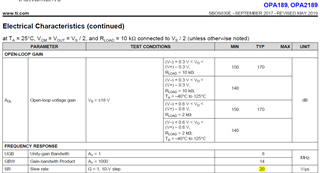Other Parts Discussed in Thread: OPA188, OPA182, TLV2888
Tool/software:
Dear Texas Support Team,
OPA189 (Rev. I) It seems that the Slew Rate in the table does not match the figure 36 at page 16.
 Fig. 36
Fig. 36
 The measured slew rate at 200kHz was significantly greater than 1V/µs. (It's fine!)
The measured slew rate at 200kHz was significantly greater than 1V/µs. (It's fine!)
TLV2888 (Initial Release) It seems that the Slew Rate in the table does not match the figure 5-40 at page 12.
 Fig. 5-40
Fig. 5-40  peak or peak-to-peak?
peak or peak-to-peak?
is the SR defined in the figures? Is there a safety surcharge that applies to a specific THD (not Vpeak*2*pi*f for sinusoidal signal)?
(Is the SR dependent on Vs by more than a factor of 2? Is the typical SR shown in the illustrations?)
By the way: Is the dependency of Vs for TLV288 unique? It is not shown in figure 36 of OPA189.
Many thanks and best regards!
p.s.
A few years ago I had problems with OPA188 (Vdd=+6V, Vss=-6V, gain=+1):


Data sheet specification is 0,8V/µs typ.


 (use zoom by mouse click on picture)
(use zoom by mouse click on picture)